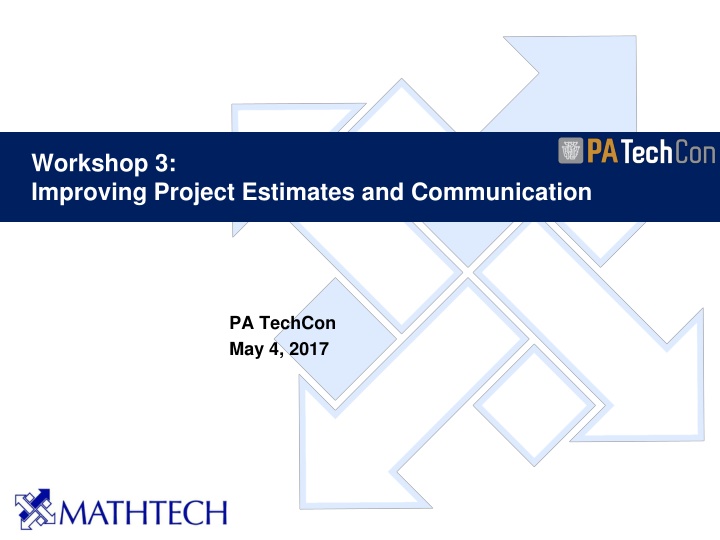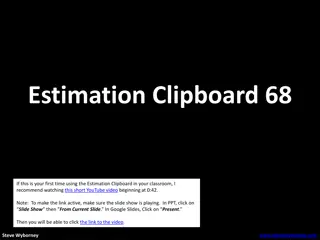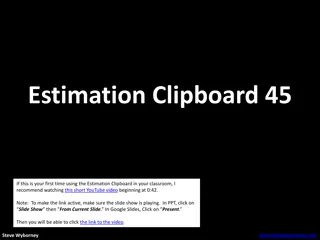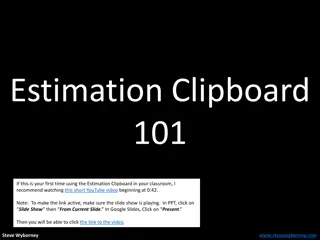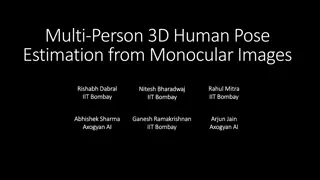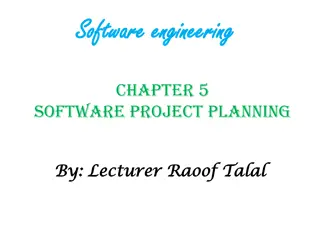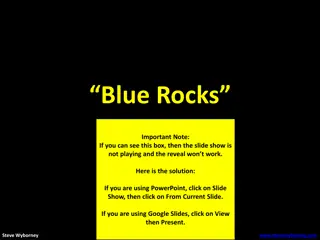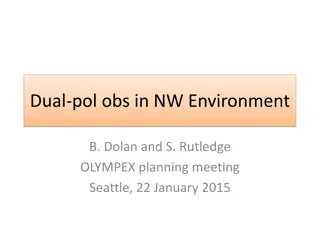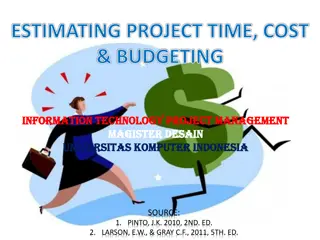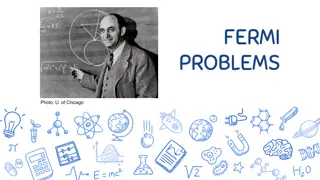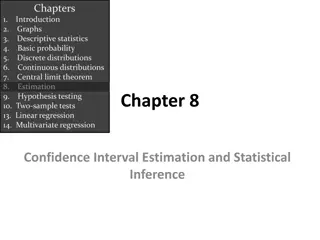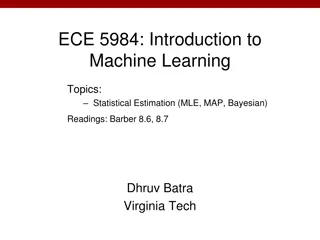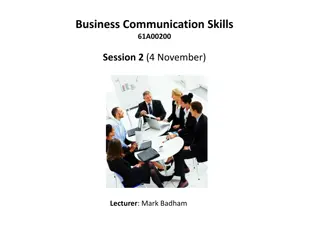Effective Project Estimation and Communication Strategies
Learn about the importance of accurate project estimates, common estimation pitfalls, key components of estimates, documenting assumptions, typical assumptions to consider, and understanding the difference between effort and duration in project planning. Enhance your project management skills for better communication and successful project execution.
Download Presentation

Please find below an Image/Link to download the presentation.
The content on the website is provided AS IS for your information and personal use only. It may not be sold, licensed, or shared on other websites without obtaining consent from the author.If you encounter any issues during the download, it is possible that the publisher has removed the file from their server.
You are allowed to download the files provided on this website for personal or commercial use, subject to the condition that they are used lawfully. All files are the property of their respective owners.
The content on the website is provided AS IS for your information and personal use only. It may not be sold, licensed, or shared on other websites without obtaining consent from the author.
E N D
Presentation Transcript
Workshop 3: Improving Project Estimates and Communication PA TechCon May 4, 2017
Agenda About Estimates Estimation Methodologies Best Practices Team Exercise Page 2
Estimates v. Commitments Requestors usually don t know the difference The Problem with Estimating Too High Could lose a bid Project canceled for lack of overestimated funds Rejection of a good solution Long term loss of credibility The Problem with Estimating Too Low Missed deadlines Lose money on bid Setup for failure Over budget Long term loss of credibility Page 3
What Are We Estimating? What will it take to complete a project? What are we estimating? Work Implementation Process & Tasks Requirements Breakdown Structure Effort Duration Resource Costs Microsoft Word & Other WBS Tools Material Costs Page 4
Document All Assumptions Document all assumption and their impact on the estimate. Clarifies the thought processes (for yourself and others) Provides a disclaimer for estimates that are not perfect predictions May calm the fears of those providing an estimate Deliver all the Assumptions in detail with the estimate. Accept that you won t have every detail it s not realistic or necessary. Page 5
Typical Assumptions Scope of Work Functionality Performance & Capacity Security Available Staff & Skills Tools & Technologies SDLC Phases (Testing, Training, Documentation) Availability and Quality of Data Timing Dependencies on Other Participants Available Facilities Procurement Timing Work Hours Turnaround on Review and Approval of Artifacts Page 6
Effort Does Not Equal Duration Many factors impact a resource s availability and effectiveness. Other Project Commitments Meetings Personal Distractions Vacations Holidays MS Project and other tools allow you to create calendars and adjust availability of resources. The Toolkit includes an adjustable factor for Hours/Day. Default = 7.5 Page 7
Communicate the Complete Estimate Communicate the estimate as a complete package that documents and highlights all information. Scope Approach Effort & Duration Material Costs Assumptions & Risks Range of Results Summarize on one page along with the details. Page 8
Estimation Methodologies Page 9
Expert Judgement The most common approach to estimation can be incredibly accurate and can be substantially abused. Find Real Experts with Hands-on Experience Make Sure Requirements are Clearly Understood Page 10
WBS Focused Top-down Bottom Up Develop Level Of Effort from the top of the WBS. Example: Estimate for the Infrastructure Divide the Infrastructure into components and validate Leverage work breakdown structure and data from previous projects Pro: Good for First Pass Con: Lacks Detailed Justification Develop Level of Effort from the bottom of the WBS. Example: Estimate for each Server Roll up all the estimates Pro: Detailed Con: Requires additional time and detail, easy to get exaggerated results if not careful When to use top down The early stages of a project to develop talking points for management When you have similar projects for comparison When time to develop an estimate is limited When high level budgetary estimates are needed to obtain funding Page 11
Parametric Model Leverage comparative or analogous projects to create a model. Extrapolate WBS components - Understand what may change Resources skills Complexity Customer Size Based on repeatable projects and work packages Uses scalable results to create new estimates Pro: fairly accurate if refined carefully over time, variations can be measured Con: takes time to build up model, many variations/parameters Page 12
Delphi Delphi is a consensus building exercise where experts provide estimates and the results are shared anonymously as input to another round of estimates. Feedback 1st Round Analysis of Results 3rd Round Analysis of Results 2nd Round Analysis of Results Feedback Feedback Page 13
PERT (Program Evaluation and Review Technique) The Beta Distribution analysis allows estimators to consider a range of outcomes. Estimate = (Optimistic + 4 * Expected + Pessimistic)/6 Consider multiple estimators Allows for the analysis of total optimistic and pessimistic scenarios The beta distribution estimation technique is used when there is a degree of uncertainty around expected durations of a work breakdown structure element. Page 14
Best Practices Document Assumptions Create a WBS Get Broad Participation Learn From History Compare Estimates Effort Does Not Equal Duration Follow a Process Communicate the Whole Estimate Page 15
Team Exercise Page 16
What Will it Take to Build a Shed in Steves Backyard Shed Requirements Dimensions 12 ft. x 12 ft. Door 6 entry Window Vents Lock Ramp No electricity Your Table is Your Team. What Questions Do You Have About The Scope? Page 17
Exercise Clarifying Scope What Questions Might We Ask? Class Discussion 5 Minutes Developing WBS Team Collaboration 5 Minutes Class Discussion 5 Minutes Developing & Estimating Tasks Team Collaboration Complete Worksheet 15 Minutes Class Discussion 10 Minutes Page 18
Realistic Scope Questions Scope Need Permits? Concrete Pad or Wooden Floor? Height? Includes Loft? Framing Spacing? Weight Capacity? Exterior Finish? Gutters? Trim work and Decorations? Approach DIY, Contractor, Kit, Pre- Built? Accounting for waste/scrap? Cleanup and disposal? What s the weather/season? Page 19
Create a Work Breakdown Structure Site Plans & Building Design Permit Concrete Pad (or footings) Frame Siding/Sheathing Roof Window Door Finished/Painted Exterior Inspection Certificate Page 20
Implementation Tasks Develop Plans Obtain Permit Buy Materials Build Foundation Build Frame Attach Siding/Sheathing Build Roof Install Window Install Door Finish Exterior (Paint, Trim, etc.) Inspection Page 21
Contact Information For more information regarding this presentation please contact: Steven E. Young, PMP, Vice President syoung@mathtechinc.com Frank Nestore, PMP, Director syoung@mathtechinc.com Mathtech, Inc. Mathtech, Inc. 2465 Kuser Road Suite 200 Hamilton, NJ 08690 Phone: 609-689-8520 www.mathtechinc.com Page 22
